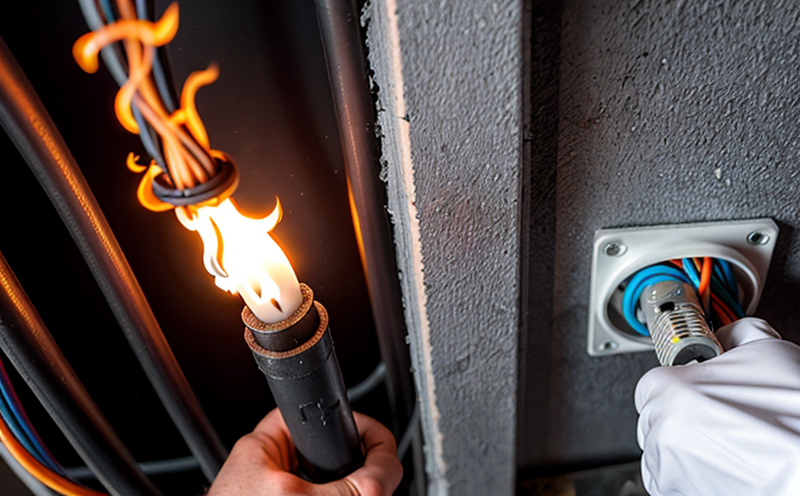Cables & Wiring Fire Resistance Testing
Fire resistance testing of cables and wiring is a critical component in ensuring safety standards are met across various sectors including construction, aerospace, automotive, and telecommunications. This testing ensures that the materials used can withstand high temperatures without compromising on performance or integrity. The primary goal is to prevent fires from spreading due to faulty connections or insulation, which could lead to significant property damage and loss of life.
The process involves subjecting samples of cables and wiring to controlled fire environments designed to simulate real-world conditions under extreme heat exposure. Different types of tests may be conducted depending on the specific application of the cable or wire being tested. For instance, power distribution cables might undergo different test procedures compared to communication cables used in data centers.
One key aspect of this testing is understanding how each type of insulation behaves when exposed to flames. Some insulations melt and drip more than others, which can contribute to fire spread if not properly managed. This behavior must be quantified during the test process so that appropriate measures can be taken in design and manufacturing stages.
Another important consideration is the temperature at which a cable starts to lose its mechanical properties or electrical conductivity due to exposure to heat. This point, known as the melting or softening temperature, plays a crucial role in determining both the performance limits of the product and potential hazards it poses when exposed to fire.
Standardized testing methods such as those outlined by ASTM E726-18 and IEC 60332 provide clear guidelines on how these tests should be carried out. These standards ensure consistency across different laboratories and help maintain high-quality control throughout the manufacturing process. Compliance with these standards is essential not only for meeting regulatory requirements but also for maintaining consumer trust.
Proper specimen preparation is vital before conducting any fire resistance test. This includes cleaning the samples thoroughly, ensuring they are free from contaminants that could affect test results, and cutting them into appropriate lengths suitable for the specific type of testing required. It's important to note that improper handling or incorrect measurement can lead to erroneous conclusions about a product’s performance capabilities.
During the actual testing process itself, precise control over environmental variables such as temperature, humidity, and airflow is necessary to ensure accurate measurements. Specialized equipment like furnace chambers equipped with sensors for monitoring these parameters are used extensively in modern laboratories. Once the sample has been exposed to flame according to prescribed protocols, careful observation of its behavior under fire conditions follows.
The results obtained from these tests provide valuable insights into areas such as flame spread rates, smoke production levels, and structural integrity retention post-fire exposure. These metrics are then used by manufacturers to improve their products continually while adhering strictly to relevant safety regulations.
Why It Matters
The importance of fire resistance testing cannot be overstated, especially given the increasing number of building fires worldwide. These incidents often result from electrical faults caused by poorly designed or inadequately maintained wiring systems. By subjecting cables and wires to rigorous fire tests, manufacturers can identify weak points early on in development cycles which allows them to address issues before they become critical.
From a regulatory perspective, compliance with national and international standards is mandatory for most industries dealing with electrical products. Not adhering to these regulations carries severe penalties including fines and potential product recalls. Therefore, investing time into thorough fire testing helps organizations avoid costly legal disputes while enhancing their reputation among customers who value safety above all else.
In addition to protecting human lives directly impacted by fires, effective fire resistance measures contribute significantly towards minimizing property damage costs associated with firefighting efforts after an incident occurs. This makes it economically viable for companies operating within high-risk environments like commercial buildings or industrial facilities where accidents could have devastating effects if left unchecked.
Moreover, sustainable practices are becoming increasingly important in today’s society as environmental awareness grows. Using fire-resistant materials reduces the likelihood of accidental fires which helps preserve natural resources by preventing unnecessary waste generation from frequent replacements due to failure under extreme conditions.
Environmental and Sustainability Contributions
Beyond immediate safety concerns, employing advanced fire resistance testing also benefits the environment through reduced resource consumption. By identifying issues early in development stages, manufacturers can reduce material waste by eliminating non-compliant products before they enter mass production phases. This approach aligns well with broader sustainability goals aimed at minimizing ecological footprints associated with manufacturing processes.
Additionally, promoting longevity of building structures and infrastructure components indirectly supports green initiatives by extending their useful lives without requiring premature replacements. Longer-lasting materials mean less frequent recycling needs which translates into lower carbon emissions throughout a product’s lifecycle.
The adoption of fire resistance testing also encourages innovation within industries focused on creating safer environments for occupants while simultaneously reducing overall energy consumption requirements. For example, developing new types of insulation materials that perform well in both low- and high-temperature conditions allows designers to balance thermal efficiency needs with safety criteria more effectively.
Competitive Advantage and Market Impact
In a competitive market where consumers increasingly demand safer products, demonstrating commitment through rigorous fire resistance testing can set companies apart from competitors. It signals reliability and trustworthiness which builds customer loyalty over time. A strong reputation built around quality assurance measures like this can attract new business opportunities both domestically and internationally.
From an operational standpoint, having reliable data available regarding a product's performance under fire exposure conditions provides valuable input for continuous improvement initiatives aimed at enhancing overall quality standards. This ongoing effort contributes positively to maintaining market share against emerging rivals who may not prioritize similar investments into research & development activities.
In summary, incorporating comprehensive fire resistance testing into operational procedures offers numerous advantages beyond mere compliance with regulatory requirements. It enhances brand reputation, fosters innovation, supports environmental sustainability efforts, and ensures long-term profitability by securing customer satisfaction and loyalty.





